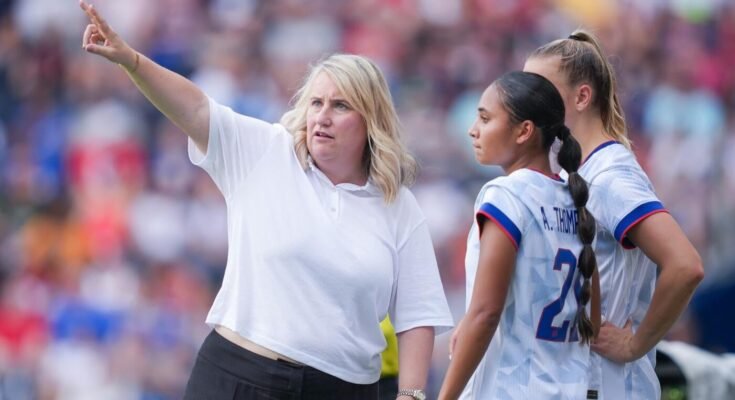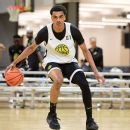The United States national women’s team may not have a major tournament to fear this year, but the so-called “off” year has already been important for the group, which could set the tone for the 2027 Women’s World Cup and at the 2028 Olympic Games.
The real work of head coach Emma Hayes began after the team won Olympic gold last year in Paris, Hayes spending the months since the development of the players’ swimming pool and offering significant experiences to a group of Venus. The results were impressive – many players who are new in the ultra -competitive environment of the USWNT settled well and left their brand in the matches, taking advantage of the opportunities in front of them. Barely a year after the start of work, Hayes has already done the hard work of widening the pool of players.
Nearly 50 players have played the 15 USWNT matches from last year’s Olympic Games, giving Hayes and the company that a lot of work with a new phase of team development begins in the fall. The head coach has targeted this month’s friendly match against Canada, a 3-0 victory in Washington, DC, such as the conclusion of its main project to expand the alignment, the next step to identify the best players in a pool of around 50 and develop chemistry with less than two years until the World Cup.
The USWNT’s calendar for the rest of the year is not yet confirmed, although they will probably play four to six games in the fall, because FIFA reserved an international window in October and another from the end of November to early December to finish 2025.
In the meantime, here are the scenarios to keep an eye on the rest of the year.
Build a new basic list
Hayes and its coach staff spent the best part of the year identifying the amounts that could play a role in the 2027 World Cup or in 2028, largely without discrimination of their impact so that they can have an impact. The head coach corrects the course on a long-standing question she had with her predecessors, arguing that she “inherited” a small pool of players of excessive value on veteran talents. The opportunity was also ripe – the USWNT was just under three years old at the clock between the Olympic Games in Paris and the World Cup BrazilAllowing coaches and players the comfort of developing at a reasonable rate.
Nine months, 15 games and 49 players later, Hayes now has a real familiarity with the players’ swimming pool that will serve as a precious basis for its tactical vision for the next three years. The next phase, however, will probably see the head coach decide what more than 20 players lead the race for the world cup alignment places, answers that could arrive in October. However, it is very unlikely that the door is closed to anyone, however-Hayes herself said that some players will spend time with the U-23 national team if it means that they have a better time at playing time, a place where they will have a chance to impress enough to join the senior team. He adds a new layer of competition to an already competitive environment, a strategy that Hayes considers an essential element of his plans to ensure that the USWNT remains one of the best world teams.
Reintroduction of veterans
During the era of the USWNT’s experimentation, Hayes prioritized work with fresh faces rather than the list that won Olympic gold in Paris and although a large part of it was intentional, part was forced. A batch of players like Nomi size And Trinity Rodman have been unavailable by injuries, while Mallory Swanson and Sophia Wilson are currently on maternity leave, so there is a limited understanding of how new arrivals would rank among the pillars. The next few months will offer many answers on this front, but there are enough to extrapolate while waiting.
Since October, six of the seven players at the top of the list of minutes played were part of the winning team of the gold medal, with the midfielder Sam Coffey And the Emily Sonnett defender leading the pack. Things tend in the opposite direction for some, however – midfielder Korbin Albert and the front Saw have not been in the mixture since April and joined the U-23 team in June, while the defenders Jenna Nighswonger And Casey Krueger have not played since last year. The same goes for the goalkeeper Murphy Caseywho was Alyssa NaeherBackup at the Olympic Games, but was not with the team from a training camp in January. It is a signal that the veterans who will be back in the mixture this fall will be those which, according to Hayes, are on the right track to be part of the team in 2027 and 2028, the head coach may finally start to build the team in his image.
Who is the starting goalkeeper?
Of all the ulophration of the USWNT programming, the starting position for the goal remains the largest unknown.
Six goalkeepers have played since the Olympic Games, including Alyssa Naeher in her last games before retiring from the national team, all with varied quantities of playing time. Mandy McGlynn Tops the group with four games, but it’s not a massive advance – Phallon Tullis-Joyce has three, while Jane Campbell and Claudia Dickey Everyone has played twice and Murphy once. This really painted an image that the race to be Naeher’s successor is indeed to be won, with potentially illuminative October matches as to the way Hayes classifies these shooting caps.
Murphy’s lack of playing time is perhaps the most surprising development here as a long-standing lining in Naeher, but Hayes may have used the last 15 games to experiment as much as possible. She had Good Things to say about the group, describing Tullis-Joyce as “leading to this field at this time in its age category” before the June matches in June, and Dickey as “probably the most efficient goalkeeper in the NWSL this season”.
No triple espresso, no problem?
The triple espresso of Rodman, Swanson and Wilson has not played together from the Olympic Games, but the USWNT has not had exactly difficult to mark without them, the historic embarrassment of the wealth team in this category should continue for another generation. A handful of players have also made real progress in this field on the ground, among them Alyssa Thompson. The participant in the 2023 World Cup ranks third for the minutes played from the Olympic Games and has four goals and a help along the way, ranking third for the contributions of the goals during this section and probably has the best case to stay in the running for a starting role, with or without triple espresso.
Thompson is not the only one to make his minutes count, however. Yazmeen Ryan And Ally Sendnor is in the top 10 for the minutes played on the USWNT since October, the latter really impresses in his first games in the senior national team. Sendnor has four goals and two assists in 467 minutes of play, with an average contribution every 77.83 minutes. Catarina Macario, finally back regularly with the group after fighting injuries for a better part of three years, has three goals and two assists in 391 minutes of play, on average a goal contribution every 78.2 minutes. Veteran Lynn BiyendoloMeanwhile, it did not miss a beat – it ranks in the top 10 of the USWNT during the minutes played and leads the group in the contributions of goals with six goals and a decisive pass during this period. Each of the best artists has a real argument as beginners, creating a share of good problems for Hayes and its staff in the years to come.
Lily Yohannes and the image of the midfielder
Hayes was very prudent in distributing opportunities to a wide variety of players, but if there is a face of the project focused on young people, it is the 18 -year -old midfielder Lily Yohannes. The coach staff were rightly patient with Yohannes, who has only played 373 minutes from the Olympic Games, but the next two years will be very important for her and the national team as a whole. Yohannes has moved to OL Lyonnes de l’Ajax this summer, translating the next phase of its development at the club level and giving itself enough time to achieve its potential. The signs are clear, however, that the 18 -year -old has the potential to be a transformative figure in the USWNT midfielder, who has shouted for a certain balance in recent years.
The team’s midfielder looks unbalanced since Sam Mewiss And Julie ErtzThe time, while regular starters ended before the Olympic Games delayed in the 2020 pandemic in Tokyo, the first dealing with injuries before retiring and the last time missing during maternity leave before retiring. Former head coach Vlatko Andonovski also had trouble finding the right mix during the 2023 World Cup while the USWNT took place on a race of more than 200 minutes without scoring a goal, and Hayes did not really find the response to the Olympic Games in Paris. Run with a combination of Coffey, Albert, Lindsey Heaps and Rose lavaUswnt de Hayes sometimes felt stowed and left much to be desired.
Coffey looks like a pillar with Hayes at this stage, playing more minutes than anyone from the Olympic Games, and Yohannes looks like a player on which USWNT bets in time for the 2027 World Cup. This leaves a fairly small number of spots that are to be won, however – LAVELLE is probably a healthy starter, and there may be no other player in the pool that offers a similar profile in terms of technical skills and attack. The 19 -year -old Claire Hutton This seems to really increase the ranks, which could force certain difficult decisions of Hayes, in particular with regard to the role of Heaps. She is still at the front of the peloton for a few minutes, ranking fourth in this category from the Olympic Games, and it seems unlikely that Hayes will abandon it anytime soon. Finding the right adjustment in a crowded field will probably be the most difficult tasks of Hayes and although it has time to understand how to find balance, determine how to do it, it will be the key.



